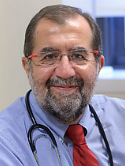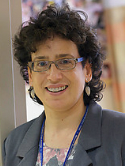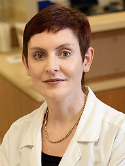A phase I-II dose escalation trial of clofarabine plus melphalan and thiotepa followed by unmodified allogeneic stem cell transplant (SCT) for the treatment of high risk or advanced acute leukemia Meeting Abstract
| Authors: | Boulad, F.; Kernan, N. A.; Prockop, S. E.; Scaradavou, A.; Small, T. N.; Klein, E. G.; Barker, J.; Jakubowski, A. A.; Koehne, G.; Papadopoulos, E.; Perales, M. A.; Young, J. W.; O'Reilly, R. J. |
| Abstract Title: | A phase I-II dose escalation trial of clofarabine plus melphalan and thiotepa followed by unmodified allogeneic stem cell transplant (SCT) for the treatment of high risk or advanced acute leukemia |
| Meeting Title: | 52nd Annual Meeting of the American Society of Hematology (ASH) |
| Abstract: | High-risk or advanced acute leukemias are associated with poor outcome even with the use of stem cell transplantation (SCT) with or without total body irradiation (TBI). Based on encouraging results with the use of clofarabine (CLO) for reinduction treatment of acute leukemias, we have developed a phase I/II protocol using this agent with melphalan (Mel) and thiotepa (Thio) followed by unmodified SCT for the treatment of patients (pts) with high-risk (HR) leukemias. To date, 28 consecutive pts were treated on, or as per protocol, with 26 pts evaluable for follow-up. There were 15 males and 11 females aged 1-58 years (median 5.3 years). Cytoreduction consisted of CLO at dose lever I of 20 mg/m2/day x 5 days (n =23) or at dose level II of 30 mg/m2/day x 5 (n=3), Thio 10 mg/Kg/day x 1 day and Mel 70 mg/m2/day x 2 days. Graft-versus-host disease (GvHD) prophylaxis consisted of tacrolimus and mycophenolate mofetil (MMF), or tacrolimus and methotrexate. Twenty pts had acute lymphoblastic leukemia (ALL) in complete remission (CR1; n=5), CR2 (n=5), CR3 (n=9), or relapse (n=1). Five pts had acute myeloid leukemia (AML), in CR1 (n=1), CR2 (n=2), or CR3 (n=2). One pt had myelodysplastic syndrome (MDS) in RAEB. For the pts with ALL in CR1, very HR features included: Infant MLL (N=2), Philadelphia (Ph1) chromosome (N=2) and Induction failure (N=1). For the pts with ALL in CR2, HR features included: Infant MLL (N=1), 2nd SCT (N=1), Ph1 and 2nd SCT (N=2), while 1 pt had prior CNS infarcts precluding the use of TBI. The one pt with AML in CR1 had M7-AML. This was a first SCT for 14 pts, a 2nd SCT for 11 pts and 3rd SCT for 1 pt, with time from previous SCT to the present one being 5-73 months (median 11.3 mo) for those 12 pts. Donors were HLA-matched siblings (n=8), HLA matched unrelated donors (n=8), or HLA mismatched unrelated donors (N=10). Stem cell grafts were bone marrow (n=12), peripheral blood (n=7) or double cord blood (n=7) stem cells.Twenty four of the 26 evaluable pts engrafted, while 2 pts died prior to engraftment. Toxicity of the SCT cytoreduction included elevation of hepatic transaminases in 17 of 26 evaluable pts (AST elevation of 5-19 fold and ALT elevation of 7-16 fold), with a subsequent normalization in all pts. Mucositis was mostly at acceptable grade 1-2 levels. Two pts developed a syndrome of renal and hepatic insufficiency leading to hepatic veno-occlusive disease (VOD) (1 pt at each of the 2 dose levels). Non-relapse mortality included: VOD (N=2), infections (N=3), treatment related sarcoma, a malignancy secondary to the irradiation received with a prior transplant (N=1).With a follow-up of 3-57 mos (median 21 mos), 15 of the 26 pts are alive, disease-free. Five pts relapsed and 4 died subsequently of disease, while 6 pts died of non-relapse morality. Overall (OS) and disease-free survival (DFS) at 2 years were both 58%. DFS was 56% for pts > 18 years and 53% for pts < 18 years (p=0.36); it was 64% for recipients of a first HSCT and 41% (p=0.97) for recipients of a second or third HSCT. Five pts (4 recipients of unrelated donor SCT; 3 from mismatched donors) developed Grade 2-4 acute GvHD. Four of these pts went on to develop chronic GvHD. Immune reconstitution was rapid; for the evaluable pts, it included absolute CD4 counts > 200 cells/L at 1-3 mos for 15 pts and at 4-8 mos for 4 pts.This cytoreductive regimen represents a promising approach for the transplantation of patients with high risk acute leukemias. It was well tolerated for pts requiring a second SCT and is also associated with rapid immune recovery. Ultimately, a large scale study would need to be done to determine if this approach could offer equal or superior results to TBI containing regimens for ALL or AML. |
| Keywords: | immune reconstitution; immune recovery; dose escalation trial; stem cell graft |
| Journal Title: | Blood |
| Volume: | 116 |
| Issue: | 21 |
| Meeting Dates: | 2010 Dec 4-7 |
| Meeting Location: | Orlando, FL |
| ISSN: | 0006-4971 |
| Publisher: | American Society of Hematology |
| Date Published: | 2010-11-19 |
| Start Page: | 973 |
| Language: | English |
| ACCESSION: | BIOSIS:PREV201100424897 |
| PROVIDER: | biosis |
| PUBMED: | 22276300 |
| DOI: | 10.1182/blood.V116.21.2354.2354 |
| Notes: | --- - Meeting Abstract: 2354 - 52nd Annual Meeting of the American-Society-of-Hematology (ASH) - Orlando, FL, USA - December 04 -07, 2010 - Amer Soc Hematol - "Source: Biosis" |
Altmetric
Citation Impact
BMJ Impact Analytics
MSK Authors
-
 512
512Kernan -
 234
234Small -
 329
329Boulad -
 262
262Prockop -
 246
246Scaradavou -
 420
420Papadopoulos -
 459
459Jakubowski -
 946
946Perales -
 335
335Barker -
 194
194Koehne -
 320
320Young -
 748
748O'Reilly -
 50
50Klein
Related MSK Work


